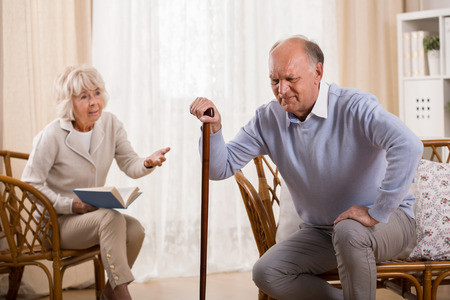Musculoskeletal Disorders: Arthritis and Osteoporosis
צוות iSavta | 13.11.2019

Musculoskeletal disorders affect movement. Injury and age-related changed are common causes:
ARTHRITIS
Arthritis means joint (arth) inflammation (itis). Pain and decreased mobility occur in affected joints. Osteoarthritis (degenerative joint disease) occurs with aging, joint injury, and obesity. The hips, knee, spine, fingers, and thumbs are commonly affected. Joint stiffness occurs with rest and lack of motion. Pain occurs with weight-bearing and joint motion. Severe pain can interfere with rest and sleep. Cold weather and dampness increase the symptoms.
Treatment:
- Relieving pain and stiffness.
- Doctors often order drugs and local applications of heat or cold for pain.
- For obese persons, weight loss is need.
- Some people need canes and walkers.
- Falls are prevented.
- Assistance with ADL is given as needed.
- Elevated toilet seats are helpful when hips and knees are affected.
- Joint replacement surgery may be necessary.
Rheumatoid arthritis (RA) is a chronic disease. It occurs at any age and is more common in women. The disease affects the heart, lungs, eyes, kidneys, and skin. Mainly the joints are affected. Small joints in the fingers, hands, and feet are affected first. Large joints are involved eventually. Joint inflammation usually occurs on both sides of the body. For example, if the right wrist in involved, so is the left wrist.
Severe inflammation causes very painful and swollen joints. The person limits movement with severe pain. As the disease progresses, more and more joints become involved. Organ changes eventually occur.
Treatment:
- Maintain joint motion, control pain, and prevent deformities.
- Rest is balanced with exercise.
- Good alignment is essential.
- Turning and repositioning are done at least every 2 hours. Positioning prevents contractures and promotes comfort.
- The person needs 8 to 10 hours of sleep and morning and afternoon rest periods.
- Range-of-motion exercises are done.
- Walking aids may be needed.
- Splints may be applied to the affected body parts.
- Safety measures to prevent falls are practiced.
- The doctor orders drugs for pain.
- Local applications of heat or cold maybe ordered.
- Back massages are relaxing.
- Joint replacement surgery may be indicated.
The disease is chronic. Death from other organ involvement is always possible. A good attitude and being active are important. The more that persons can do for themselves, the better off they are. Provide encouragement and praise. Listen when the person needs to talk.
Total joint replacement Arthroplasty is the surgical replacement (plasty) of a joint (arthro). Ankle, knee, hip, shoulder, wrist, finger and toe joints can be replaced. The disease joint is removed and replaced with prosthesis. Pain is relieved and joint motion restored.
OSTEOPOROSIS
Osteoporosis is a bone (osteo) disorder in which the bone becomes porous and brittle (porosis). Bones are fragile and break easily. Spine, hip, and wrist bones are often affected. Older persons and women after menopause are at risk. The lack of estrogen after menopause results in bone changes. Lack of dietary calcium is also a cause. Smoking, high alcohol intake, and lack of exercise are risk factors. Bed rest and immobility are other causes. Immobility does not allow for proper bone use. For bone to form properly, it must bear weight. If not, calcium is absorbed in the bone becomes porous and brittle.
Signs and symptoms:
- Low back pain
- Gradual loss of height
- Stooped posture.
Fractures are a major risk. With brittle bones, the slightest stress can cause a fracture. Turning in bed or getting up from a chair can cause fractures. They are great risk from falls or accidents.
Treatment:
- Doctors order calcium and vitamin supplements.
- Estrogen is often ordered for women after menopause.
- Weight-bearing (walking, jogging) are best.
- Good posture is important.
- Some people wear a back brace or corset or need walking aids.
- Protect the person from falls and accidents.
- Turn and reposition the person gently.












